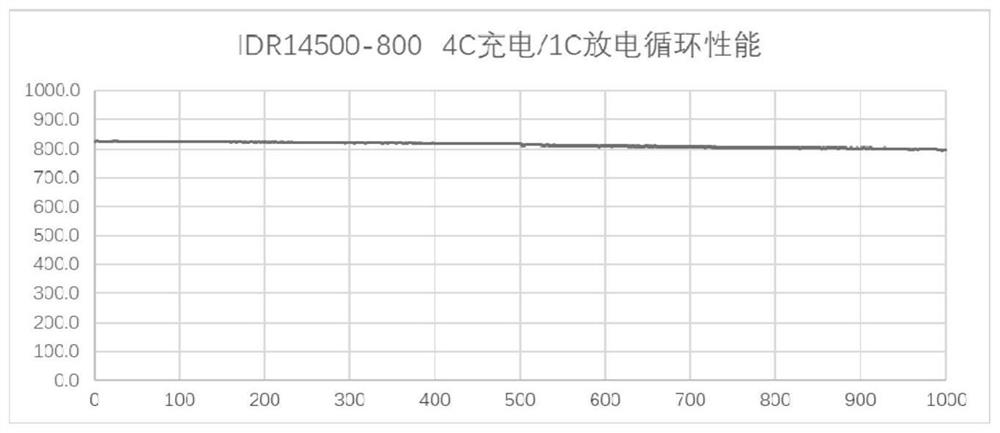Lithium ion battery
A lithium-ion battery, lithium iron phosphate technology, applied in battery electrodes, secondary batteries, circuits, etc., can solve the problems of immature zinc-ion battery technology, fast capacity decay, low power consumption, etc., and achieve excellent battery cycle performance, The effect of reducing electrochemical polarization and improving low temperature performance
- Summary
- Abstract
- Description
- Claims
- Application Information
AI Technical Summary
Problems solved by technology
Method used
Image
Examples
preparation example Construction
[0078] The preparation method of lithium ion battery of the present invention comprises the following steps:
[0079] (a) Ingredients: According to the formula, the positive electrode slurry and the negative electrode slurry were respectively prepared by vacuum stirring;
[0080] (b) Coating: According to the process design, the positive electrode slurry and the negative electrode slurry are respectively coated on the positive electrode base material and the negative electrode base material to make rolls of positive electrode sheets and negative electrode sheets;
[0081] (c) Roll cutting: According to the process design, the positive pole piece and the negative pole piece are compacted and cut to make the required pole piece;
[0082] (d) Assembly: As required, assemble into cylindrical, square, polymer flexible packaging, etc.;
[0083] (e) Liquid injection: inject the corresponding electrolyte according to the battery performance requirements;
[0084] (f) Activation and ...
Embodiment 1
[0089] A lithium-ion battery, comprising a positive electrode material, a negative electrode material, an electrolyte, a separator, a positive electrode matrix, and a negative electrode matrix;
[0090] The positive electrode material is made of a positive electrode active material with a mass ratio of 95:2:3:50, a positive electrode conductive agent, a positive electrode binder and a positive electrode solvent; the positive electrode active material is lithium cobaltate, and the positive electrode conductive agent is Carbon nanotubes, the positive electrode binder is PVDF, the positive electrode solvent is N-methylpyrrolidone; the viscosity of the positive electrode slurry is 12000mPa·s;
[0091] The negative electrode material is made of negative electrode active material, negative electrode conductive agent, negative electrode binder and negative electrode solvent with a mass ratio of 96:1.5:2.5:130; the negative electrode active material is lithium titanium phosphate, and t...
Embodiment 2
[0095] A lithium-ion battery, comprising a positive electrode material, a negative electrode material, an electrolyte, a separator, a positive electrode matrix, and a negative electrode matrix;
[0096] The positive electrode material is made of a positive electrode active material, a positive electrode conductive agent, a positive electrode binder and a positive electrode solvent with a mass ratio of 90:3.5:6.5:40; the positive electrode active material is lithium vanadium phosphate, and the positive electrode conductive agent is Carbon nanotubes, the positive electrode binder is PVDF, the positive electrode solvent is N-methylpyrrolidone; the viscosity of the positive electrode slurry is 13000mPa·s;
[0097] The negative electrode material is made of negative electrode active material, negative electrode conductive agent, negative electrode binder and negative electrode solvent with a mass ratio of 92:3.5:4.5:120; the negative electrode active material is lithium titanium pho...
PUM
| Property | Measurement | Unit |
|---|---|---|
| Viscosity | aaaaa | aaaaa |
| Viscosity | aaaaa | aaaaa |
| Thickness | aaaaa | aaaaa |
Abstract
Description
Claims
Application Information
 Login to View More
Login to View More - R&D
- Intellectual Property
- Life Sciences
- Materials
- Tech Scout
- Unparalleled Data Quality
- Higher Quality Content
- 60% Fewer Hallucinations
Browse by: Latest US Patents, China's latest patents, Technical Efficacy Thesaurus, Application Domain, Technology Topic, Popular Technical Reports.
© 2025 PatSnap. All rights reserved.Legal|Privacy policy|Modern Slavery Act Transparency Statement|Sitemap|About US| Contact US: help@patsnap.com



